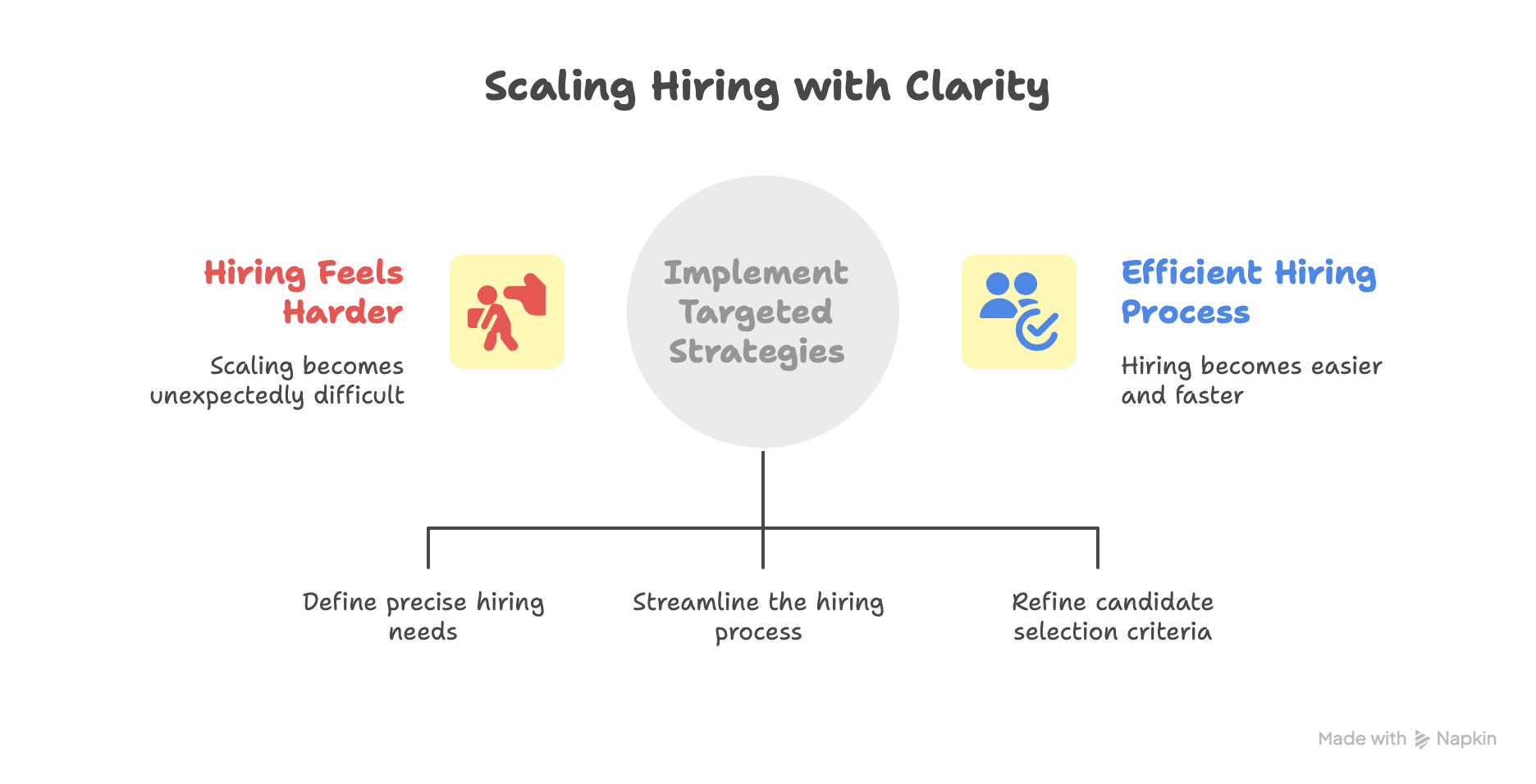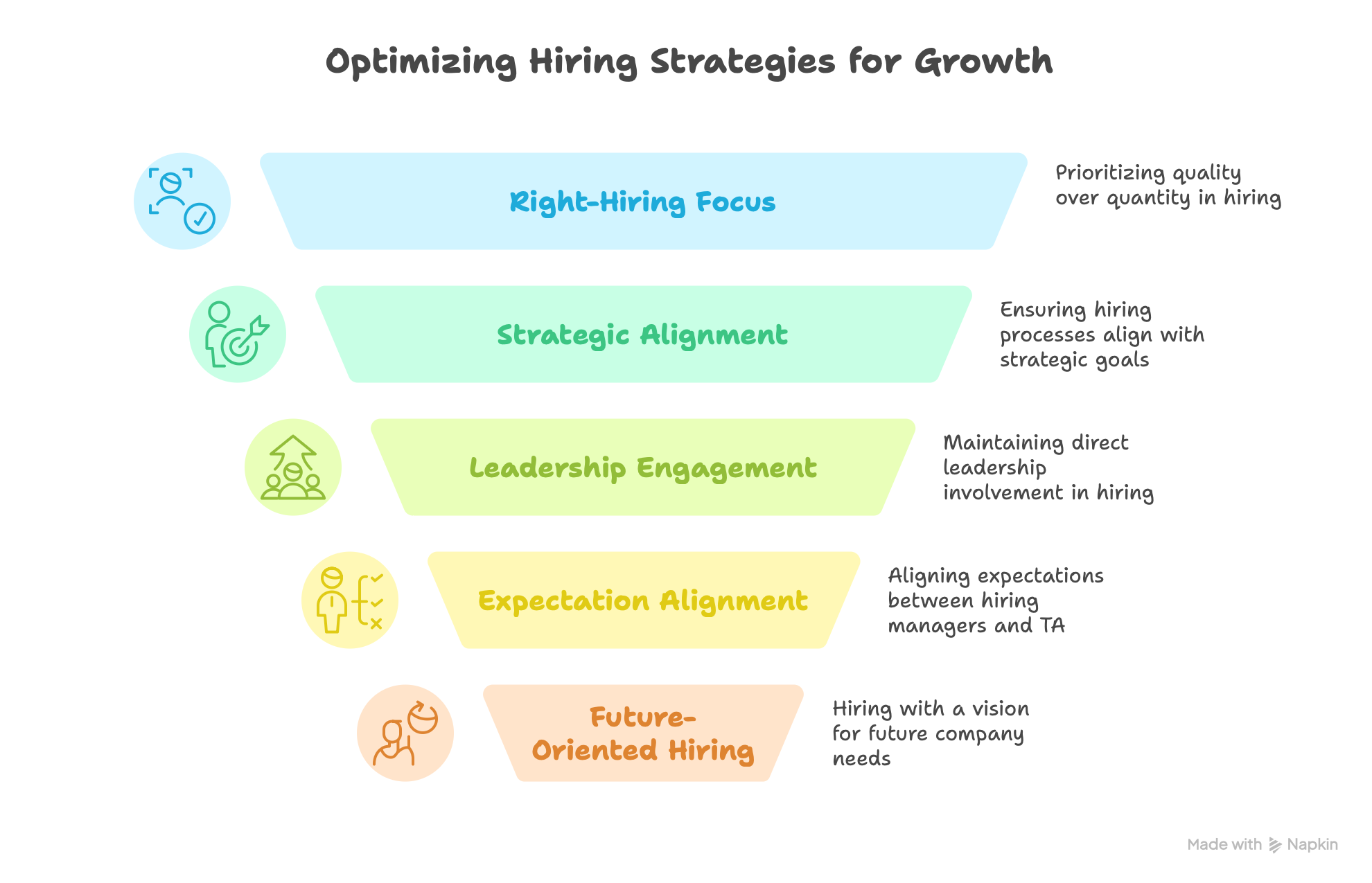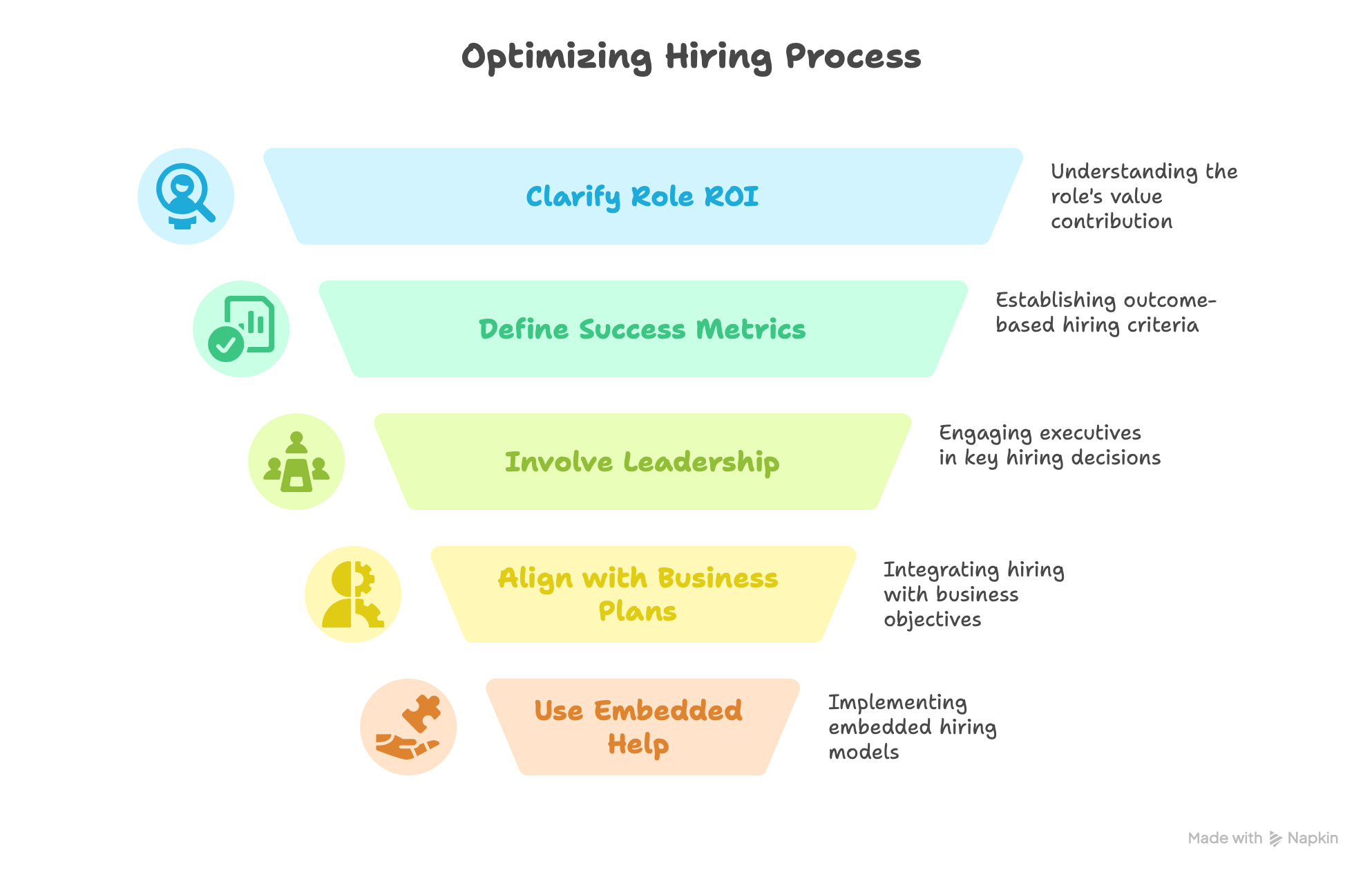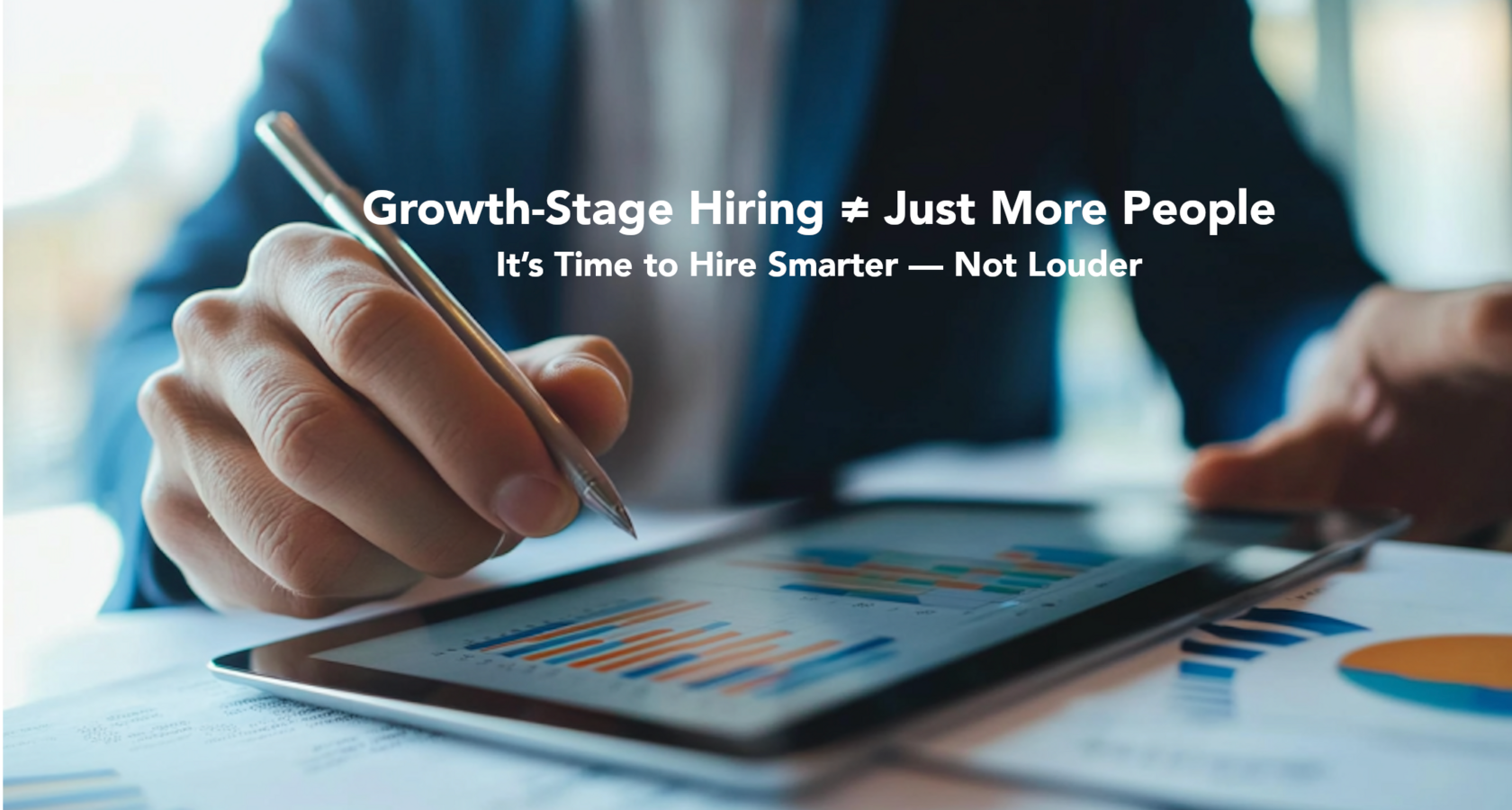You’ve raised funding. You’re ready to scale. But suddenly, hiring feels harder — not easier.
Many growth-stage startups struggle with hiring strategy, confusing process with clarity. To scale effectively, founders must avoid these common startup hiring mistakes and align talent acquisition with growth plans.
Why? Because hiring at the growth stage isn’t about more — it’s about different.
What worked during scrappy, founder-led recruiting no longer scales. But traditional HR playbooks don’t fit either.
The $2.8 Million Cost of Growth-Stage Hiring Mistakes
The Growth-Stage Hiring Crisis:
- 67% of Series A/B companies report hiring as their #1 scaling challenge (First Round State of Startups)
- Average cost of a mis-hire at growth stage: $240,000 in salary, training, and replacement costs
- Growth-stage startups lose 18 months of momentum per major hiring mistake (CB Insights)
- Companies that nail growth-stage hiring scale 3x faster than those that struggle
The Paradox:
More funding should make hiring easier, but most growth-stage companies find it becomes exponentially harder.

This article breaks down the most common hiring mistakes growth-stage startups make — and how to fix them with clarity, speed, and precision.
5 Common Hiring Mistakes Growth-Stage Startups Make

1. Over-hiring instead of right-hiring
You don’t need 10 product managers. You need the right next hire who moves the roadmap forward.
Hiring by headcount targets — without clarity on why and what success looks like — leads to bloat, not momentum.
2. Confusing process with strategy
Adding an ATS, scorecards, and interview training doesn’t solve a broken hiring strategy.
Growth-stage companies often “professionalize” processes — but forget to revisit their ideal candidate profiles, narrative, or actual team gaps.
🎯 Hiring isn’t about polish — it’s about focus + execution.
3. Delegating hiring too early or too far
Founders and leaders start stepping out too fast — and stop selling the vision.
But at growth stage, A-players still expect direct access to leadership.
When hiring becomes too abstracted, great candidates drop off.
4. Misaligned expectations between hiring managers and TA
At scale, misfires often happen because:
- TA is optimizing for speed
- Hiring managers are optimizing for quality
- No one agrees on “what good looks like”
The result? Interview loops that drag, offers that get rejected, and hires that don’t stick.
5. Hiring for now, not for future state
You’re not just hiring for today’s needs — you’re hiring for where the company will be in 12–18 months.
That means understanding growth curves, scaling pressure, and team evolution.
Great hiring is a mix of realism and vision.
CB Insights: 23% of startup failures linked to team issues.
SHRM: Companies with structured hiring see 50% higher retention.
LinkedIn: Growth-stage startups that involve leadership in hiring close 2x more top candidates.
Startup Hiring Checklist for Scaling with Clarity
✅ Principle💡 How to Apply It

Clarify role ROI
Why does this role matter now? How will it generate or protect value?
Define success, not tasks
Write hiring scorecards based on outcomes, not just activities.
Involve leadership in key hires
Keep execs in the loop for narrative, signal, and close.
Sync hiring plans with business plans
Align TA planning with OKRs, GTM, and product milestones.
Use embedded help, not just agencies
Need velocity + context? 👉 Try an embedded model.
👉 Interesting? Let's Talk!
From Startup Chaos to Scalable Hiring
Growth-stage hiring is where good startups stumble — or surge.
The difference? Not budget. Not process maturity.
It’s clarity, alignment, and the ability to evolve how you hire as fast as your product grows.
At UnitiQ, we help companies translate strategy into hiring action — without the chaos.
A Series B SaaS startup doubled headcount in 6 months — but 40% churned due to misaligned hires. After realigning hiring scorecards with business OKRs, retention jumped by 25%.
Hiring Strategy by Growth Sub-Stage
Series A (10-25 employees):
- Focus: Build core team foundations with proven execution ability
- Key hires: Senior IC roles who can execute and train others
- Hiring velocity: 2-4 hires per month maximum
- Leadership involvement: Founders in final rounds for all senior hires
Series B (25-75 employees):
- Focus: Scale proven systems with management layer
- Key hires: Department heads and specialized senior roles
- Hiring velocity: 5-8 hires per month with structured process
- Leadership involvement: Founders for VP+ roles, department heads for senior IC
Series C+ (75-200 employees):
- Focus: Optimize and systematize with executive leadership
- Key hires: C-level executives and specialized team leads
- Hiring velocity: 8-15 hires per month with dedicated TA team
- Leadership involvement: Founders for C-suite, department VPs for directors
Table Summary
The 90-Day Growth-Stage Hiring Transformation
Days 1-30: Assessment and Alignment
- Audit current hiring process and identify bottlenecks
- Align hiring managers and TA on success criteria for each role
- Define 12-18 month hiring roadmap based on business plan
- Create role ROI framework for prioritizing positions
Days 31-60: Process and Systems
- Implement outcome-based hiring scorecards
- Establish leadership involvement protocols
- Set up embedded recruiting support or upgrade agency partnerships
- Create candidate experience optimization
Days 61-90: Optimization and Scaling
- Launch refined hiring process with all stakeholders
- Implement feedback loops and continuous improvement
- Scale successful approaches across all departments
- Prepare for next growth phase hiring needs
Growth-Stage Hiring Scenarios: Playbook for Common Situations
Scenario 1: Scaling Engineering Team
- Challenge: Need to 3x engineering team in 6 months
- Solution: Hire 2-3 senior engineers first, then scale with their help recruiting
- Key metric: Senior hire success rate vs. junior hire productivity
Scenario 2: Building Sales Organization
- Challenge: Transition from founder-led sales to scalable sales team
- Solution: Hire proven sales leader first, then build team with their input
- Key metric: Revenue per new sales hire within 90 days
Scenario 3: International Expansion
- Challenge: Hiring in new markets with different talent dynamics
- Solution: Partner with local embedded recruiters, adjust compensation frameworks
- Key metric: Time to productivity for international hires vs. domestic
Growth-Stage Hiring: Strategic Questions Answered
What are the biggest hiring mistakes growth-stage startups make?
Over-hiring, confusing process with strategy, delegating hiring too far, misalignment between TA and managers, and hiring for today instead of the future.
How can growth-stage startups improve hiring?
By clarifying role ROI, involving leadership, aligning TA with OKRs, and using embedded recruiting support.
Why is clarity so critical in growth-stage hiring?
Because every hire shapes culture and execution speed — misfires at scale cost months of runway and lost momentum.
How do you maintain culture while scaling hiring rapidly?
Focus on hiring for values and potential, not just skills. Implement structured culture interviews, involve culture carriers in the process, and create strong onboarding that reinforces cultural principles.
When should you hire a head of talent vs. using external help?
Hire internal TA leadership when consistently hiring 8+ people per month and have complex multi-department needs. Before that, embedded recruiting or fractional TA leadership provides better ROI.
How do you compete for talent against larger companies?
Emphasize growth opportunities, equity upside, direct impact potential, and access to leadership. Focus on candidates seeking career acceleration rather than stability.
What's the ideal hiring manager to recruiter ratio?
At growth stage, 1 dedicated recruiter can support 3-5 hiring managers effectively. Beyond that, you need specialized recruiters for different functions or seniority levels.
How do you prevent hiring bias when scaling quickly?
Use structured interviews, diverse interview panels, standardized scorecards, and data-driven decision making. Speed pressure often amplifies bias, so extra structure is crucial.
What metrics matter most for growth-stage hiring?
Track quality of hire (90-day performance ratings), time-to-productivity, hiring manager satisfaction, candidate experience scores, and offer acceptance rates for priority roles.
Related Reading
👉 Stop repeating growth-stage hiring mistakes. UnitiQ helps founders scale teams with clarity, speed, and precision — turning talent strategy into competitive advantage. Book a consult today.
About Author
Olga Fedoseeva is an award-winning HR executive and people strategist with over 20 years of international experience across EMEA, the US, and APAC. Currently Chief of Staff at Exponential Science and Founder of UnitiQ, she has personally hired more than 1,000 employees and scaled organizations from 30 to 3,000 staff. Recognized as one of the Top HR Women in EV (2021), Olga has led global HR transformation, talent acquisition, and people operations for startups, scale-ups, and multinational enterprises. Her expertise spans the full HR lifecycle—succession planning, DEI, HR tech integration, workforce planning, and executive coaching—helping businesses align people strategies with growth objectives while fostering inclusive, high-performance cultures.
